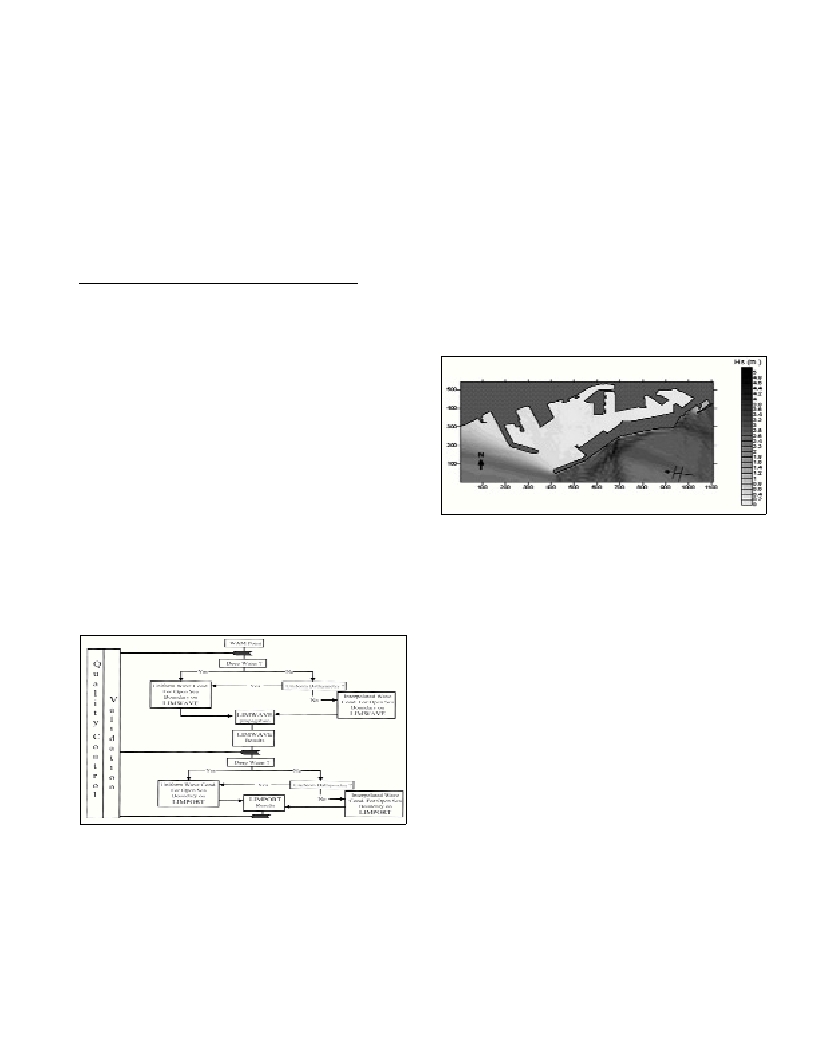Rapp. Comm. int. Mer Médit., 37,2004
104
HARBOUR WAVE CONDITIONS IN THE NW MEDITERRANEAN COAST. NESTING AND FORECASTING.
Daniel González Marco
1
*, Agustín Sánchez-Arcilla
1
, Rodolfo Bolaños
1
, Joan Pau Sierra
1
,
Sergi Paricio
2
and Eliseu Vilaclara
2
.
1
Laboratori d´Enginyeria Marítima, LIM-CIIRC DEHMA. ETSECCPB Universitat Politécnica de Catalunya. c/ Jordi Girona 1-3,
Módul D-1, Campus Nord, C.P. 08034, Barcelona, Spain.
*daniel.gonzalez-marco@upc.es, agustin.arcilla@upc.es, rodolfo.bolanos@upc.es, joan.pau.sierra@upc.es
2
Servei Meteorològic de Catalunya, c/ Berlín nº 38-46 C.P. 08029, Barcelona, Spain. sparicio@meteocat.com,
evilaclara@meteocat.com
Abstract
This paper addresses the performance envelope of wave forecasting under fetch and duration limited conditions such as those found in the
NW Mediterranean. The main aim is to develop an operational tool, which helps harbour and coastal authorities on taking decisions. The
emphasis is thus on: 1) Accuracy, 2) Resolution, 3) Forecasting horizon, 4) Robustness of the obtained predictions. The sequence of nested
wave models will be validated for this purpose with the meteorological and oceanographic data recorded by the XIOM network
(Oceanographic and Meteorological Instruments Network) of the SMC (Catalan Meteorological Service).
Keywords: wave generation, wave propagation, nesting
Harbour and coastal issues in a coast such as the Spanish
Mediterranean are extremely significant for the economic activities of
the zone and for the safety of the numerous populations there
concentrated. The forecasting of wave conditions is within this
framework important for the management of harbour activities and
also for the management of beach touristical activities (under
operational conditions). Likewise the forecasting of wave conditions
is essential for the design of harbour infrastructures and for the
mitigation of erosion and ?ooding damages and even loss of life
(survival or extreme conditions).
For this purpose a suite of nested models has been adapted to the
fetch and duration limited conditions found in the NW Mediterranean.
This sequence (schematised in Fig.1) starts with the WAM model for
wave generation (1). This third generation model feeds a phase
averaged wave model (LIMWAVE, 2) which propagates the spectral
density function from the closest WAM grid point to the harbour
entrance area. This result is used to feed a third model (LIMPORT)
which can be, depending on the objectives, either a Boussinesq based
model (3) or an elliptic wave model (based on the Mild-Slope
equation, 4). This nesting introduces a number of hard to quantify
uncertainties through closure submodels (e.g. bottom friction, e.g.
wind shear stress) and trough the “internal” boundary conditions.
These uncertainties are then checked with the available Meteo and
Oceanographic data recorded by the XIOM network (Oceanographic
and Meteorological Instruments Network) managed by the SMC
(Catalan Meteorological Service).
Fig. 1. Schematisation of model nesting for wave predictions near and
inside harbour domains.
The combination of nested simulations and observations has
allowed a robust prediction of wave conditions with a time horizon of
up to 36 hours. The accuracy and resolution also allow a system of
warnings for harbour and beach operation, which includes the
following variables:
1. Wave agitation
2. Wave overtopping
3. Long waves
4. Wind strength
This allows a safer and better operation of harbour infrastructures
and beach areas. As a sample of the obtained results, Figure 2 shows
the wave agitation corresponding to the recent recorded storm during
October 2003 for a Spanish Mediterranean Harbour. The sequence of
models nested is been continuously validated and updated with the
meteo-oceanographic database available.
Fig. 2. Sample illustration of simulated wave conditions inside a Spanish
Mediterranean harbour.
Acknowledgements. The authors wish to acknowledge the support
given by the project PREVIMED (contract number:
J00838REN2002-03415)
References
1-Wamdi Group, 1988. The WAM model – A tirad generation ocean
waves prediction model. J. Phys. Oceanogr.,18: 1775-1810.
2-Cáceres, I., González Marco, D., Alsina, J.M., Sierra, J.P., Sánchez-
Arcilla, A., 2002. Hydro-Morphodynamics for a LCS. A firs approach for
a Mediterranean case. Delos 1
st
Year Meeting, Barcelona 01/2002.
3-Sierra, J.P., Sánchez-Arcilla, A., Egozcue, J.J., Monsó, J.L., 1988.
Effect of Boussinesq-type equations on wave spectra propagation. XXI
Int. Conf. On Coastal Engineering, Torremolinos, pp. 350-362.
4-Liu, P.L.-F., 1990. Wave transformation. Pp. 27-63.In: The sea, Wiley-
Interscience Publication. v. 9.

